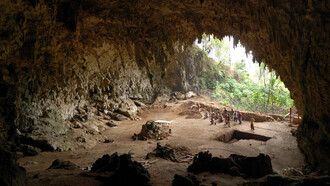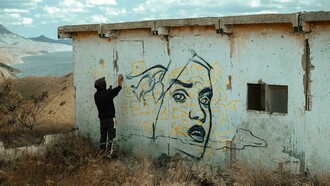The Beijing Opera is known for combining music, vocal performance, mime, dance and acrobatics. With elaborate costumes, the protagonists act in front of a characteristically sparse stage. They use their performing skills in a symbolic and suggestive way, rather than in a realistic one. Above all, the skill of the performers is evaluated according to the beauty of their movements.
That kind of beauty and movement can be observed in the paintings of Liu Shuishi, currently shown at Chase Contemporary Gallery in Chelsea, New York. His large scale canvases are inhabited by abstract figures, sometimes only one, sometimes more. Their large heads are rendered with bold brushstrokes and subtle details conferring both the energy of a theatrical dance on stage and the calmness of a quiet lake at dawn.
In “Ghost” (2012) for example, the head of a male (or female) character emerges from a blown and abstract body. The brushstrokes are fast but precise, conveying to the glaze of the eyes sharpness and to the body of the character the energy of a samurai fighter. Movement and action are clearly perceivable while an inner calmness transpires from the center.
In “Couple” (2012) a similar dynamic can be observed. Two characters stand back to back as if they were trying to avoid any (eye) contact. Their bodies speak about closeness, about connection, and shared moments while their body language evidently convey discontent. Pens and brushes traced very clear lines on top of abstract and undefined color fields. Few details are enough to let their emotions speak. Two opposites play against each others, yet, their bodies are inseparably bound together, emphasized by a red element that resembles a pulled heart, each half pulsing in one of the two bodies.
Like in most of the Chinese contemporary artists, an extensive study of European masters is as evident as the everlasting connection to their own roots. “Who Is The Corresponding One?” (2015) and “Living In The Boundaries of Thought” (2015) for example show clear influence of the attention to Italian sculptor and painter Amedeo Modigliani and Chinese calligraphy artist Xiao Ping. In “Slough” (2011) and “Subject and Object” (2015) we can read traits of the Dutch expressionist artist Willem De Kooning and Chinese ink-painter Zeng Shanqing.
The combination of two opposites in painting, both visual and conceptual, is a characteristic of Asian contemporary art and it is rooted in the Eastern philosophy. While the Western way of thinking, and its artistic expressions, is characterized by a dichotomization of concepts and thoughts, Asian art embraces the opposite. Here, complementary energies are at work, reciprocate dependencies and correlations rule existence. There is no need to negate or discuss but affirmative actions and visual elements create the narrative.
Indeed, Liu Shuishi, an avid scholar of both Asian and Western philosophy, who practices meditation on a daily basis and for many months before he even starts to paint, expresses feelings and doesn’t illustrate them. By rendering visible the underlying connections of apparent oppositions such as love and hate, struggle and peace, honesty and unfairness, communication and silence, just to name a few, Shuishi emphasizes also the hidden truth of things and asserts the possibility of a harmonious coexistence of seemingly incompatible phenomena in life.
Born in 1962, he belongs to the class of Chinese artists who experienced the turbulent atmosphere of the Cultural Revolution (1966-1972) and the events of Tiananmen Square (1989) but unlike most of his peers, who elaborate often political issues in their art, may it be as a form of protest or as a form of self-therapy, Shuishi focuses more on answering psychological questions, based on international literature and his meditation practice. “In his work, topics like desire, isolation, or sexuality are expressed in a very subtle way. He is not using China or its political issues to draw attention from the Western audience”, says the curator of the exhibition, Diana Chen, “rather, he investigates his own identity between two opposites, the East and the West.”
The other works in this exhibition are emblematic for his unique approach to art. The characters and their emotions, are defined by a masterly mix of precise and undefined brushstrokes, by large, monochrome areas and small, colorful components. Facial expressions are rendered with little details. They clearly define deep sentiments, at the same time there is enough leeway to the viewer’s imagination. Their stories are never narrated through realistic posing or descriptions, rather, like in the Chinese Opera, they are told with suggestive, allusive forms, shapes and a energetic way of mastering the paint itself. Liu Shuishi is represented by Chase Contemporay Gallery, New York.















